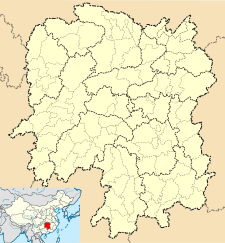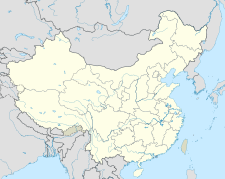The former residence of Lei Feng (simplified Chinese: 雷锋故居; traditional Chinese: 雷鋒故居; pinyin: Leí Fēng Gùjū) was the birthplace and childhood home of Lei Feng, a soldier in the People's Liberation Army. The residence is located in Leifeng Subdistrict of Wangcheng District, in northwestern Changsha, South Central China's Hunan province.[2] It is currently a tourist attraction in Hunan.[3][4]
| Former Residence of Lei Feng | |
|---|---|
雷锋故居 | |
 Entrance of the Former Residence of Lei Feng. | |
| General information | |
| Type | Traditional folk houses |
| Location | Leifeng Subdistrict, Wangcheng District, Changsha, Hunan |
| Country | China |
| Coordinates | 28°12′45″N 112°51′14″E / 28.212559°N 112.854003°E |
| Completed | 1900s |
| Opened | 1993 |
| Renovated | 1993 |
| Technical details | |
| Floor area | 180 m2 (1,900 sq ft)[1] |
History
editDuring the Qing dynasty (1644–1911), the former residence was established, then belonged to the landlord. On December 18, 1940, Lei Feng was born in the former residence of the old house, he lived until November 1956 when he was transferred to Wangcheng County. In 1958, the former residence was abandoned due to lack of maintenance. Lei Feng's cousin Lei Guangming rebuilt three thatched huts, and in the winter of 1966, the Hunan Provincial People's Government built a new Lei Feng Memorial Hall next to the former residence, and on November 20, 1968, Lei Feng Memorial Hall was officially opened to the public. In 1993, the People's Government of Wangcheng County rebuilt the residence and opened it to the public.[5]
In January 2011, Hunan Provincial People's Government listed Lei Feng's former residence in the ninth batch of Hunan Provincial Cultural Relics Protection Units.[6]
Building
editLei Feng statue, located in the Lei Feng statue square, sculpted by the sculptor Zhu Weijing, with 5 meters high. Lei Feng Memorial Hall, located next to his former residence, was built in 1966-1968. On October 29, 1990, Jiang Zemin, then General Secretary of the Chinese Communist Party, inscribed it as "Lei Feng Memorial Hall".[7] In 2002, the National Tourism Administration classified it as a 4A-level tourist attraction.[5][8]
Gallery
edit-
Statue of Lei Feng
-
Kitchen
-
Hunan Province Cultural Relics Protection Unit signage
References
edit- ^ Shu Chi (2016-11-14). 【首届湖南文物解读大赛】雷锋故居讲解词. rednet (in Chinese).
- ^ 长沙市学雷锋志愿服务主题活动在雷锋纪念馆举行. wenming.cn (in Chinese). 2017-02-24. Archived from the original on 2017-04-24. Retrieved 2017-02-25.
- ^ Zheng Chao (2017-02-23). 长沙特警参观雷锋纪念馆 争当雷锋式“平安侠”. changsha.cn (in Chinese).
- ^ Jie Jinying (2017-01-24). 2016年长沙望城区雷锋纪念馆共接待国内外游客145万人次. rednet (in Chinese).
- ^ a b 湖湘文化辞典(八) (in Chinese). BEIJING BOOK CO. INC. 2011. p. 89. ISBN 978-7-999008-97-2. Retrieved 2024-04-30.
- ^ Yang Zhongmin (杨忠民) (2019). 雷锋精神与红色文化 (in Chinese). Pishu Publishing Branch of the Social Science Literature Publishing House. p. 21. ISBN 978-7-5201-5253-2. Retrieved 2024-04-30.
- ^ 第三代领导人的足迹 (in Chinese). CCP Central Party School Press. 1992. p. 206. ISBN 978-7-5035-0567-6. Retrieved 2024-04-30.
- ^ 永远丰碑:爱国主义教育示范基地名单公布. 共和国故事 (in Chinese). Jilin Publishing Group Co., Ltd. 2011. p. 25. ISBN 978-7-5463-1840-0. Retrieved 2024-04-30.

